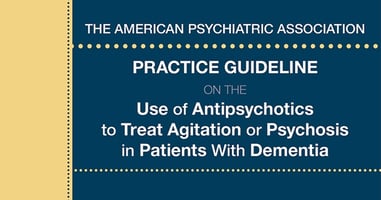APA Releases Updated Practice Guideline for Treatment of Patients With Schizophrenia
 |
The APA Practice Guideline for the Treatment of Patients With Schizophrenia, Third Edition, replaces the previous practice guideline released in 2004. It is also the first APA guideline for an entire disorder that uses standards set forth by the Institute of Medicine in 2011 to ensure clinical guidelines meet high standards of transparency and scientific rigor.
As with APA’s previous guidelines, clinical recommendations were made by a diverse group of experts following a systematic evaluation of relevant literature. The expert work group made 24 recommendations spread across the topics of patient assessment and treatment planning, pharmacotherapy, and psychosocial interventions.
For the key first step of patient assessment, the guideline recommends that patients with schizophrenia receive a thorough evaluation, including assessments of a patient’s physical health; cognitive health; their risk of harming themselves or others; and substance use, including nicotine. Afterward, physicians and patients should work together on a comprehensive, person-centered treatment plan that includes evidence-based pharmacological and nonpharmacological treatments.
The guideline reaffirms that patients diagnosed with schizophrenia should be treated with an antipsychotic medication and that patients whose symptoms improve while taking an antipsychotic medication should continue with maintenance antipsychotic treatment. With the exception of clozapine—recommended as the first choice for treatment-resistant schizophrenia, patients with high suicide risk, and patients with a high risk of aggressive behavior—the guideline does not make any recommendations about specific oral or long-acting injectable antipsychotics. The guideline, does, however, include detailed tables with dosing considerations, metabolic properties, and potential side effects of all FDA-approved antipsychotics.
“Although there may be clinically meaningful distinctions in response and tolerability of different antipsychotic medications in an individual patient, there is no definitive evidence that one antipsychotic will have consistently superior efficacy compared with another, with the possible exception of clozapine,” the work group wrote.
Among psychosocial interventions, the guideline strongly recommends that patients receive cognitive-behavioral therapy for psychosis, education about schizophrenia, and supported employment services. The guideline also strongly recommends that patients experiencing their first episode of psychosis are treated in a coordinated specialty care program. If possible, patients should also receive interventions aimed at developing their self-management skills.
All the outlined recommendations “should be made in collaboration with the patient, whenever possible, and should incorporate the patient’s personal and sociocultural preferences and values in order to enhance the therapeutic alliance, adherence to treatment, and treatment outcomes,” the work group wrote.
To read more about this topic, check out APA’s Schizophrenia Resource Center.
(Image: iStock/SDI Productions)





